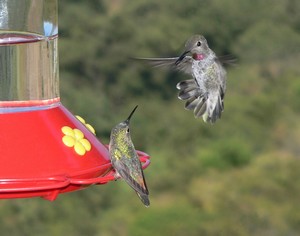 |
| Fall colors in the Pasayten |
In my last post, "Gardener as gambler", I was thinking about how I hedge my bets in the garden, watching the weather forecast, harvesting some produce while risking the loss of some to eke out the last golden days of Indian summer.
Living here in the Methow Valley, the observant human witnesses natural gambling in every season. I know from studying natural history, that in every population of plants, insects, and animals, there exist outliers - those individuals who push the envelope just a little by reproducing or migrating earlier or later in the season, or expanding into new territory.
 |
| Photo from Birdwatching-bliss.com |
Hummingbirds are one obvious example. They move up the valley each spring, gaining elevation, probably following the blooming willows and wild currants. What benefits do the early comers derive? Nights often drop below freezing when I observe my first hummer in April, and I rush to put out a hummingbird feeder to provide calories to the cold little gamblers. Every fall I'm sure all the hummers have headed south and I'm ready to take down the feeder when one little guy will show up for another drink. I had a visitor to the feeder at breakfast today, October 11. "Fly south you little knucklehead!"
There are A LOT of mule deer here. Our property is on the East Chewuch "deer highway" which connects the town deer (yes, that's what we call them) with the good foraging up river. I won't share my thoughts on the deer population with you today, just know that they are doing VERY WELL.
 |
| Mule deer youth in our front yard. |
We observe our first spotted fawn each year in May or June. This year I'm pretty sure that one doe produced triplets, but I don't know if all three survived. Each year in the fall, we notice that some of the first-year fawns are noticeably less robust than their peers. They were probably born later. I actually say to them, "Eat up, winter's coming", because once snow lies and there's nothing green to eat, those little guys will begin to starve. They must survive off whatever fat they've managed to store up in their first summer of life. Here's the hard part. Every winter, Frank and I haul frozen yearling mule deer carcasses off the property after the lethal nights of the cold moon (January) and the hunger moon (February).
 |
| Frank in "the tube" sliding off the porch roof. |
Every winter there's a thaw period, sometimes accompanied by the "Pineapple Express", a warm wind that blows out of the Pacific Ocean. Daytime and nighttime temperatures may stay above freezing for a week or more, snow slides off the roof, and we'll actually have puddles of meltwater on the driveway. Guess who shows up about then? Mosquitoes. That's right, every winter some number of mosquitoes hatch out during the thaw, only to perish before reproducing. It's a gamble that must pay off some years, to be that first mosquito to hatch out in the spring.
 |
| Asparagus on May 5 |














